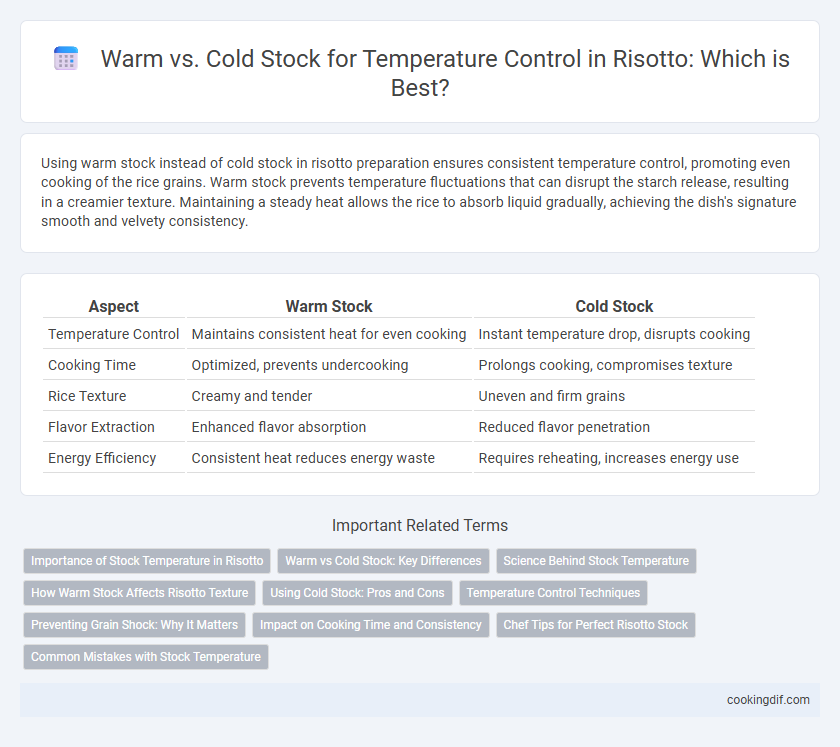Using warm stock instead of cold stock in risotto preparation ensures consistent temperature control, promoting even cooking of the rice grains. Warm stock prevents temperature fluctuations that can disrupt the starch release, resulting in a creamier texture. Maintaining a steady heat allows the rice to absorb liquid gradually, achieving the dish's signature smooth and velvety consistency.
Table of Comparison
| Aspect | Warm Stock | Cold Stock |
|---|---|---|
| Temperature Control | Maintains consistent heat for even cooking | Instant temperature drop, disrupts cooking |
| Cooking Time | Optimized, prevents undercooking | Prolongs cooking, compromises texture |
| Rice Texture | Creamy and tender | Uneven and firm grains |
| Flavor Extraction | Enhanced flavor absorption | Reduced flavor penetration |
| Energy Efficiency | Consistent heat reduces energy waste | Requires reheating, increases energy use |
Importance of Stock Temperature in Risotto
Maintaining warm stock is crucial for achieving the ideal creamy texture in risotto, as it ensures even cooking and prevents the rice from cooling down during the gradual liquid absorption process. Using cold stock can disrupt the cooking temperature, resulting in unevenly cooked grains and a less smooth consistency. Consistently warm stock promotes optimal starch release from the rice, essential for the risotto's signature silky finish.
Warm vs Cold Stock: Key Differences
Warm stock maintains a consistent temperature that prevents the rice from cooling down during cooking, ensuring even starch release and a creamy texture in risotto. Cold stock lowers the overall temperature, slowing the cooking process and potentially leading to unevenly cooked grains and a less cohesive dish. Maintaining warm stock is critical for achieving the optimal al dente bite and smooth creaminess characteristic of authentic risotto.
Science Behind Stock Temperature
The temperature of the stock used in risotto preparation significantly impacts starch gelatinization and rice cooking consistency. Warm stock maintains a steady cooking environment, allowing starch granules in Arborio rice to swell evenly and release amylopectin, which ensures a creamy texture. In contrast, adding cold stock cools the cooking surface, disrupting temperature control and resulting in uneven starch release and a less cohesive risotto texture.
How Warm Stock Affects Risotto Texture
Warm stock maintains a consistent temperature throughout the cooking process, allowing the rice grains to absorb liquid evenly and cook uniformly. This results in a creamy, al dente texture characteristic of perfect risotto. Using cold stock can interrupt the cooking temperature, leading to unevenly cooked rice and a less cohesive texture.
Using Cold Stock: Pros and Cons
Using cold stock in risotto preparation helps maintain precise temperature control, preventing the rice from cooking too quickly and allowing gradual absorption of flavors. Cold stock slows down starch release, resulting in a creamier texture but may extend overall cooking time. However, the longer cooking period can risk uneven heat distribution, potentially affecting the final consistency of the risotto.
Temperature Control Techniques
Using warm stock in risotto preparation ensures consistent temperature control, promoting even starch release and a creamy texture. Cold stock lowers the pot's temperature, disrupting the cooking process and risking uneven doneness. Maintaining stock at around 80-90degC optimizes heat transfer, allowing precise absorption and preventing temperature drops during gradual incorporation.
Preventing Grain Shock: Why It Matters
Using warm stock instead of cold stock in risotto preparation is crucial for maintaining consistent cooking temperature, preventing grain shock that causes uneven texture. Gradual temperature control allows rice grains to absorb liquid evenly, producing a creamy and tender risotto. Sudden temperature drops can halt starch release, leading to undercooked or overly firm grains, diminishing dish quality.
Impact on Cooking Time and Consistency
Using warm stock instead of cold stock in risotto cooking significantly reduces the overall cooking time by maintaining a steady temperature, which allows the rice to absorb liquid more efficiently and cook evenly. Cold stock causes temperature fluctuations that slow down the cooking process and can lead to inconsistent texture or unevenly cooked grains. Consistently warm stock ensures a creamy, smooth risotto with uniform softness throughout each grain.
Chef Tips for Perfect Risotto Stock
Using warm stock instead of cold stock is crucial for maintaining the risotto's cooking temperature and ensuring even absorption of liquid by the rice grains. Gradually adding warm stock prevents temperature drops, which can cause uneven cooking and a gummy texture. Chefs recommend keeping the stock simmering on a separate burner to sustain its warmth throughout the risotto preparation process.
Common Mistakes with Stock Temperature
Using cold stock instead of warm stock when making risotto commonly leads to inconsistent cooking and uneven rice texture due to the sudden temperature drop. Warm stock maintains a steady heat, allowing the rice to absorb liquid gradually and release starch evenly for a creamy finish. Introducing stock at the wrong temperature can cause undercooked grains or a longer cooking time, disrupting the ideal al dente consistency.
Warm stock vs cold stock for temperature control Infographic

 cookingdif.com
cookingdif.com